How Can Drones Uncover Land Degradation Hotspots and Restoration Hopespots? An Integrated Approach in the Mount Elgon Region with Community Perceptions
Abstract
:1. Introduction
2. Materials and Methods
2.1. Study Area
2.2. Drone Image Acquisition and Processing
2.2.1. Sampling Plan and Site Selection
2.2.2. Aerial Image Acquisition
2.2.3. Production of Orthomosaics
2.3. Land Degradation and Restoration Activities
2.4. Smallholder Farmers’ Perceptions
2.5. Data Analysis Techniques
3. Results
3.1. Land Use Change (2020–2023)
3.2. Smallholder Farmers’ Perceptions
3.3. Land Utilization and Management
The natural forest cover in 1980s was evergreen but now is disappearing with more extensive farmland in the community and patchy tree cover in the park. Grassland, bushland and shrubs are being converted into subsistence farms due to high population in this area and a need for more land to grow cabbages, and onions.
Most communities around Mount Elgon harvest several park resources including; dry poles, mushrooms, herbs and bamboo shoots (malewa). The rate of harvesting has rapidly increased due to external demand and yet the original purpose was intended for communities surrounding the park. For instance, malewa is highly demanded and is on sell during peak seasons in Mbale city and even in Kampala.
3.4. Land Degradation
Our hillslopes in Bududa are very vulnerable to soil erosion and landslides than ever before, because we till our fields in preparation for planting. We always lose a lot of top soil once rainy season starts and landslides also occur because the slopes are very steep and bare. The color of water in the rivers is more reddish especially in March and April and most recently, our community lost an access road, a water spring, crop fields, and tree plantations when a landslide happened in 2022.
Forest encroachment in Mount Elgon has occurred since colonial era, especially along on the gentle slopes in the park. Illegal trails from the communities into the park exist and occurrence of human-induced forest fires at night further accelerates encroachment. Besides, monitoring and enforcement of conservation laws has been hampered by limited human resource, court injunctions, and the hilly terrain.
3.5. Soil and Water Conservation (SWC)
The quality of my farm and produce was very poor before attending MWARES trainings on farm management. The farm is now healthy, organized and more fertile because of pruning coffee, digging trenches, and planting napier grasses and calliandra on farm edges. I am excited because my farm harvest is now very good.
3.6. Socio-Economic Factors Explaining Resource Extraction, Land Degradation, and SWC Measures
Our father divided about 1.50 hectares of land among five of us (his children) and I got 0.4 hectares. The farming space will reduce further if I dig trenches or establish contour lines in my farmland. Therefore, I am only composting, mulching the farmland, and planting napier grass on the farm edges.
4. Discussion
4.1. Land Use Change
4.2. Smallholder Farmers’ Perception
4.3. Land Utilization and Management
4.4. Land Degradation
4.5. Soil and Water Conservation (SWC) Measures
4.6. Socio-Economic Factors Explaining Resource Extraction, Land Degradation, and SWC Measures
5. Conclusions
Supplementary Materials
Author Contributions
Funding
Data Availability Statement
Acknowledgments
Conflicts of Interest
References
- UNEP. From Hotspots to Hopespots: Connecting Local Changes to Global Audiences. Environ. Dev. 2013, 8, 95–104. [Google Scholar] [CrossRef]
- Lira, P.K.; Portela, R.d.C.Q.; Tambosi, L.R. Land-Cover Changes and an Uncertain Future: Will the Brazilian Atlantic Forest Lose the Chance to Become a Hopespot? In The Atlantic Forest: History, Biodiversity, Threats and Opportunities of the Mega-Diverse Forest; Marques, M.C.M., Grelle, C.E.V., Eds.; Springer Nature Switzerland: Cham, Switzerland, 2021; pp. 233–251. ISBN 9783030553227. [Google Scholar]
- Kaivosoja, J. Future Possibilities and Challenges for UAV-Based Imaging Development in Smart Farming. In New Developments and Environmental Applications of Drones; Lipping, T., Linna, P., Narra, N., Eds.; Springer: Helsinki, Finland, 2022; pp. 117–128. ISBN 9783030778590. [Google Scholar]
- D’Oleire-Oltmanns, S.; Marzolff, I.; Klaus, D.P.; Ries, J.B. Unmanned Aerial Vehicle (UAV) for Monitoring Soil Erosion in Morocco. Remote Sens. 2012, 4, 3390–3416. [Google Scholar] [CrossRef]
- Tarolli, P.; Straffelini, E. Agriculture in Hilly and Mountainous Landscapes: Threats, Monitoring and Sustainable Management. Geogr. Sustain. 2020, 1, 70–76. [Google Scholar] [CrossRef]
- Matricardi, E.A.T.; Skole, D.L.; Costa, O.B.; Pedlowski, M.A.; Samek, J.H.; Miguel, E.P. Long-Term Forest Degradation Surpasses Deforestation in the Brazilian Amazon; American Association for the Advancement of Science: Washington, DC, USA, 2020; Volume 369. [Google Scholar]
- Ali, N.; Hu, X.; Hussain, J. The Dependency of Rural Livelihood on Forest Resources in Northern Pakistan’s Chaprote Valley. Glob. Ecol. Conserv. 2020, 22, e01001. [Google Scholar] [CrossRef]
- Sassen, M.; Sheil, D.; Giller, K.E.; ter Braak, C.J.F. Complex Contexts and Dynamic Drivers: Understanding Four Decades of Forest Loss and Recovery in an East African Protected Area. Biol. Conserv. 2013, 159, 257–268. [Google Scholar] [CrossRef]
- Betela, B.; Wolka, K. Evaluating Soil Erosion and Factors Determining Farmers’ Adoption and Management of Physical Soil and Water Conservation Measures in Bachire Watershed, Southwest Ethiopia. Environ. Chall. 2021, 5, 100348. [Google Scholar] [CrossRef]
- Makabayi, B.; Musinguzi, M.; Otukei, J.R. Estimation of Ground Deformation in Landslide Prone Areas Using GPS: A Case Study of Bududa, Uganda. Int. J. Geosci. 2021, 12, 213–232. [Google Scholar] [CrossRef]
- Broeckx, J.; Maertens, M.; Isabirye, M.; Vanmaercke, M.; Namazzi, B.; Deckers, J.; Tamale, J.; Jacobs, L.; Thiery, W.; Kervyn, M.; et al. Landslide Susceptibility and Mobilization Rates in the Mount Elgon Region, Uganda. Landslides 2019, 16, 571–584. [Google Scholar] [CrossRef]
- Reddy, C.S.; Bird, G.N.; Sreelakshmi, S.; Manikandan, T.M.; Asra, M.; Krishna, P.H.; Jha, C.S.; Rao, P.V.N.; Diwakar, P.G. Identification and Characterization of Spatio-Temporal Hotspots of Forest Fires in South Asia. Environ. Monit. Assess. 2019, 191, 791. [Google Scholar] [CrossRef]
- NEMA. National State of the Environment Report for Uganda 2016/17; NEMA: Kampala, Uganda, 2017. [Google Scholar]
- Duguma, L.A.; Atela, J.; Minang, P.A.; Ayana, A.N.; Gizachew, B.; Nzyoka, J.M.; Bernard, F. Deforestation and Forest Degradation as an Environmental Behavior: Unpacking Realities Shaping Community Actions. Land 2019, 8, 26. [Google Scholar] [CrossRef]
- Hussain, J.; Zhou, K.; Akbar, M.; Zafar khan, M.; Raza, G.; Ali, S.; Hussain, A.; Abbas, Q.; Khan, G.; Khan, M.; et al. Dependence of Rural Livelihoods on Forest Resources in Naltar Valley, a Dry Temperate Mountainous Region, Pakistan. Glob. Ecol. Conserv. 2019, 20, e00765. [Google Scholar] [CrossRef]
- Maniraho, A.P.; Liu, W.; Mupenzi, C.; Mind’je, R.; Nzabarinda, V.; Gasirabo, A.; Nyirarwasa, N.; Li, L. Mapping Soil Erosion and Analyzing Its Severity Using the RUSLE Model and Local Farmers’ Perception in the Agricultural Area of Rwanda. Model. Earth Syst. Environ. 2023, 9, 1069–1087. [Google Scholar] [CrossRef]
- Bamutaze, Y.; Mukwaya, P.; Oyama, S.; Nadhomi, D.; Nsemire, P. Intersecting RUSLE Modelled and Farmers Perceived Soil Erosion Risk in the Conservation Domain on Mountain Elgon in Uganda. Appl. Geogr. 2021, 126, 102366. [Google Scholar] [CrossRef]
- Kouassi, J.-L.; Gyau, A.; Diby, L.; Bene, Y.; Kouamé, C. Assessing Land Use and Land Cover Change and Farmers’ Perceptions of Deforestation and Land Degradation in South-West Côte d’Ivoire, West Africa. Land 2021, 10, 429. [Google Scholar] [CrossRef]
- Kessler, A.; van Reemst, L.; Beun, M.; Slingerland, E.; Pol, L.; De Winne, R. Mobilizing Farmers to Stop Land Degradation: A Different Discourse from Burundi. Land Degrad. Dev. 2021, 32, 3403–3414. [Google Scholar] [CrossRef]
- Nakakaawa, C.; Moll, R.; Vedeld, P.; Sjaastad, E.; Cavanagh, J. Collaborative Resource Management and Rural Livelihoods around Protected Areas: A Case Study of Mount Elgon National Park, Uganda. For. Policy Econ. 2015, 57, 1–11. [Google Scholar] [CrossRef]
- Buyinza, J.; Nuberg, I.K.; Muthuri, C.W.; Denton, M.D. Assessing Smallholder Farmers’ Motivation to Adopt Agroforestry Using a Multi-Group Structural Equation Modeling Approach. Agrofor. Syst. 2020, 94, 2199–2211. [Google Scholar] [CrossRef]
- Kessler, C.A.; van Duivenbooden, N.; Nsabimana, F.; van Beek, C.L. Bringing ISFM to Scale through an Integrated Farm Planning Approach: A Case Study from Burundi. Nutr. Cycl. Agroecosystems 2016, 105, 249–261. [Google Scholar] [CrossRef]
- Qi, W.; Li, H.; Zhang, Q.; Zhang, K. Forest Restoration Efforts Drive Changes in Land-Use/Land-Cover and Water-Related Ecosystem Services in China’s Han River Basin. Ecol. Eng. 2019, 126, 64–73. [Google Scholar] [CrossRef]
- Opedes, H.; Mücher, S.; Baartman, E.M.J.; Nedala, S.; Mugagga, F. Land Cover Change Detection and Subsistence Farming Dynamics in the Fringes of Mount Elgon National Park, Uganda from 1978–2020. Remote Sens. 2022, 14, 2423. [Google Scholar] [CrossRef]
- Suab, S.A.; Avtar, R. Unmanned Aerial Vehicle System (UAVS) Applications in Forestry and Plantation Operations: Experiences in Sabah and Sarawak, Malaysian Borneo. In Unmanned Aerial Vehicle: Applications in Agriculture and Environment; Avtar, R., Watanabe, T., Eds.; Springer International Publishing: Cham, Switzerland, 2020; pp. 101–118. ISBN 9783030271565. [Google Scholar]
- Gomez-Sapiens, M.; Schlatter, K.J.; Melendez, A.; Hernandez-Lopez, D.; Salazar, H.; Kendy, E.; Flessa, K.W. Improving the Efficiency and Accuracy of Evaluating Aridland Riparian Habitat Restoration Using Unmanned Aerial Vehicles. Remote Sens. Appl. Soc. Environ. 2021, 7, 488–503. [Google Scholar] [CrossRef]
- Ancin-murguzur, F.J.; Munoz, L.; Monz, C.; Hausner, V.H. Drones as a Tool to Monitor Human Impacts and Vegetation Changes in Parks and Protected Areas. Remote Sens. Ecol. Conserv. 2019, 6, 105–113. [Google Scholar] [CrossRef]
- Ouattara, T.A.; Sokeng, V.C.J.; Zo-Bi, I.C.; Kouamé, K.F.; Grinand, C.; Vaudry, R. Detection of Forest Tree Losses in Côte d’Ivoire Using Drone Aerial Images. Drones 2022, 6, 83. [Google Scholar] [CrossRef]
- Ecke, S.; Dempewolf, J.; Frey, J.; Schwaller, A.; Endres, E.; Klemmt, H.J.; Tiede, D.; Seifert, T. UAV-Based Forest Health Monitoring: A Systematic Review. Remote Sens. 2022, 14, 3205. [Google Scholar] [CrossRef]
- Himmelfarb, D.; Cavanagh, C.J. Managing the Contradictions: Conservation, Communitarian Rhetoric, and Conflict at Mount Elgon National Park. In Conservation and Development in Uganda; Sandbrook, C., Cavanagh, C.J., Mwesigye, T.D., Eds.; Routledge: New York, NY, USA, 2018; pp. 85–103. ISBN 978-1-138-71092-4. [Google Scholar]
- Petursson, J.G.; Vedeld, P.; Sassen, M. An Institutional Analysis of Deforestation Processes in Protected Areas: The Case of the Transboundary Mt. Elgon, Uganda and Kenya. For. Policy Econ. 2013, 26, 22–33. [Google Scholar] [CrossRef]
- Sassen, M.; Sheil, D.; Giller, K.E. Fuelwood Collection and Its Impacts on a Protected Tropical Mountain Forest in Uganda. For. Ecol. Manag. 2015, 354, 56–67. [Google Scholar] [CrossRef]
- Vedeld, P.; Cavanagh, C.; Petursson, J.; Nakakaawa, C.; Moll, R.; Sjaastad, E. The Political Economy of Conservation at Mount Elgon, Uganda: Between Local Deprivation, Regional Sustainability, and Global Public Goods. Conserv. Soc. 2016, 14, 183. [Google Scholar] [CrossRef]
- Vlaeminck, P.; Maertens, M.; Isabirye, M.; Vanderhoydonks, F.; Poesen, J.; Deckers, S.; Vranken, L. Coping with Landslide Risk through Preventive Resettlement. Designing Optimal Strategies through Choice Experiments for the Mount Elgon Region, Uganda. Land Use Policy 2016, 51, 301–311. [Google Scholar] [CrossRef]
- Misanya, D.; Tassone, V.C.; Kessler, A.; Kibwika, P.; Arjen, E.J. Analysing Farmers’ Learning for Socio-Ecological Stewardship in Eastern Uganda: A Transformative Learning Ecology Perspective. NJAS Impact Agric. Life Sci. 2023, 95, 2191795. [Google Scholar] [CrossRef]
- Opedes, H.; van Eupen, M.; Mücher, C.A.; Baartman, J.E.M.; Mugagga, F. Park Conservation or Degradation? ICLUE Modelling of Land Use Change Projections in the Upper Manafwa Watershed on Mount Elgon, Uganda. J. Nat. Conserv. 2023, 76, 126493. [Google Scholar] [CrossRef]
- Jiang, B.; Bamutaze, Y.; Pilesjö, P. Climate Change and Land Degradation in Africa: A Case Study in the Mount Elgon Region, Uganda. Geo-Spat. Inf. Sci. 2014, 17, 39–53. [Google Scholar] [CrossRef]
- Uganda Bureau of Statistics. The National Population and Housing Census 2014—Area Specific Profile Series; Uganda Bureau of Statistics: Kampala, Uganda, 2017. [Google Scholar]
- Elkhrachy, I. Accuracy Assessment of Low-Cost Unmanned Aerial Vehicle (UAV) Photogrammetry. Alex. Eng. J. 2021, 60, 5579–5590. [Google Scholar] [CrossRef]
- Ulvi, A. Documentation, Three-Dimensional (3D) Modelling and Visualization of Cultural Heritage by Using Unmanned Aerial Vehicle (UAV) Photogrammetry and Terrestrial Laser Scanners. Int. J. Remote Sens. 2021, 42, 1994–2021. [Google Scholar] [CrossRef]
- National Forestry Authority (NFA). Gazetted Areas GIS Database; National Forestry Authority (NFA): Kampala, Uganda, 2007. [Google Scholar]
- WOCAT. Where the Land Is Greener—Case Studies and Analysis of Soil and Water Conservation Initiatives Worldwide; Liniger, H., Critchley, W., Eds.; FAO, UNEP, CDE: Wageningen, The Netherlands, 2007; ISBN 9789290813392. [Google Scholar]
- WOCAT. Questionnaire on Sustainable Land Management (SLM) Technologies. A Tool to Help Document, Assess & Disseminate SLM Practices. Available online: Wocat.net/documents/189/QT_Core_EN.pdf (accessed on 8 May 2021.).
- Ul Din, S.; Mak, H.W.L. Retrieval of Land-Use/Land Cover Change (LUCC) Maps and Urban Expansion Dynamics of Hyderabad, Pakistan via Landsat Datasets and Support Vector Machine Framework. Remote Sens. 2021, 13, 3337. [Google Scholar] [CrossRef]
- Khalid, N.; Shahrol, N.A. Evaluation The Accuracy of Oil Palm Tree Detection Using Deep Learning and Support Vector Machine Classifiers. IOP Conf. Ser. Earth Environ. Sci. 2022, 1051, 012028. [Google Scholar] [CrossRef]
- Adugna, T.; Xu, W.; Fan, J. Comparison of Random Forest and Support Vector Machine Classifiers for Regional Land Cover Mapping Using Coarse Resolution FY-3C Images. Remote Sens. 2022, 14, 574. [Google Scholar] [CrossRef]
- Fragou, S.; Kalogeropoulos, K.; Stathopoulos, N.; Louka, P.; Srivastava, P.K.; Karpouzas, S.; Kalivas, D.P. Quantifying Land Cover Changes in a Mediterranean Environment Using Landsat TM and Support Vector Machines. Forests 2020, 11, 750. [Google Scholar] [CrossRef]
- Gigović, L.; Pourghasemi, H.R.; Drobnjak, S.; Bai, S. Testing a New Ensemble Model Based on SVM and Random Forest in Forest Fire Susceptibility Assessment and Its Mapping in Serbia’s Tara National Park. Forests 2019, 10, 408. [Google Scholar] [CrossRef]
- UBOS. Statistical Abstract 2022; Uganda Bureau of Statistics: Kampala, Uganda, 2022; pp. 1–336. [Google Scholar]
- Nakileza, B.R.; Nedala, S. Topographic Influence on Landslides Characteristics and Implication for Risk Management in Upper Manafwa Catchment, Mt Elgon Uganda. Geoenvironmental Disasters 2020, 7, 27. [Google Scholar] [CrossRef]
- Hailu, A.; Mammo, S.; Kidane, M. Dynamics of Land Use, Land Cover Change Trend and Its Drivers in Jimma Geneti District, Western Ethiopia. Land Use Policy 2020, 99, 105011. [Google Scholar] [CrossRef]
- da Cruz, D.C.; Benayas, J.M.R.; Ferreira, G.C.; Santos, S.R.; Schwartz, G. An Overview of Forest Loss and Restoration in the Brazilian Amazon. New For. 2021, 52, 1–16. [Google Scholar] [CrossRef]
- Nakileza, B. Horticulture in Mountain Agro-Ecosystems of Uganda: Environmental and Socio-Economic Threats and Opportunities. J. Agric. Sustain. 2017, 10, 17–33. [Google Scholar]
- Oyana, T.J.; Kayendeke, E.; Bamutaze, Y.; Kisanga, D. A Field Assessment of Land Use Systems and Soil Properties at Varied Landscape Positions in a Fragile Ecosystem of Mount Elgon, Uganda. Afr. Geogr. Rev. 2015, 34, 83–103. [Google Scholar] [CrossRef]
- Broeckx, J.; Vanmaercke, M.; Duchateau, R.; Poesen, J. A Data-Based Landslide Susceptibility Map of Africa. Earth-Sci. Rev. 2018, 185, 102–121. [Google Scholar] [CrossRef]
- Wordofa, M.G.; Okoyo, E.N.; Erkalo, E. Factors Influencing Adoption of Improved Structural Soil and Water Conservation Measures in Eastern Ethiopia. Environ. Syst. Res. 2020, 9, 13. [Google Scholar] [CrossRef]
- Sileshi, M.; Kadigi, R.; Mutabazi, K.; Sieber, S. Determinants for Adoption of Physical Soil and Water Conservation Measures by Smallholder Farmers in Ethiopia. Int. Soil Water Conserv. Res. 2019, 7, 354–361. [Google Scholar] [CrossRef]
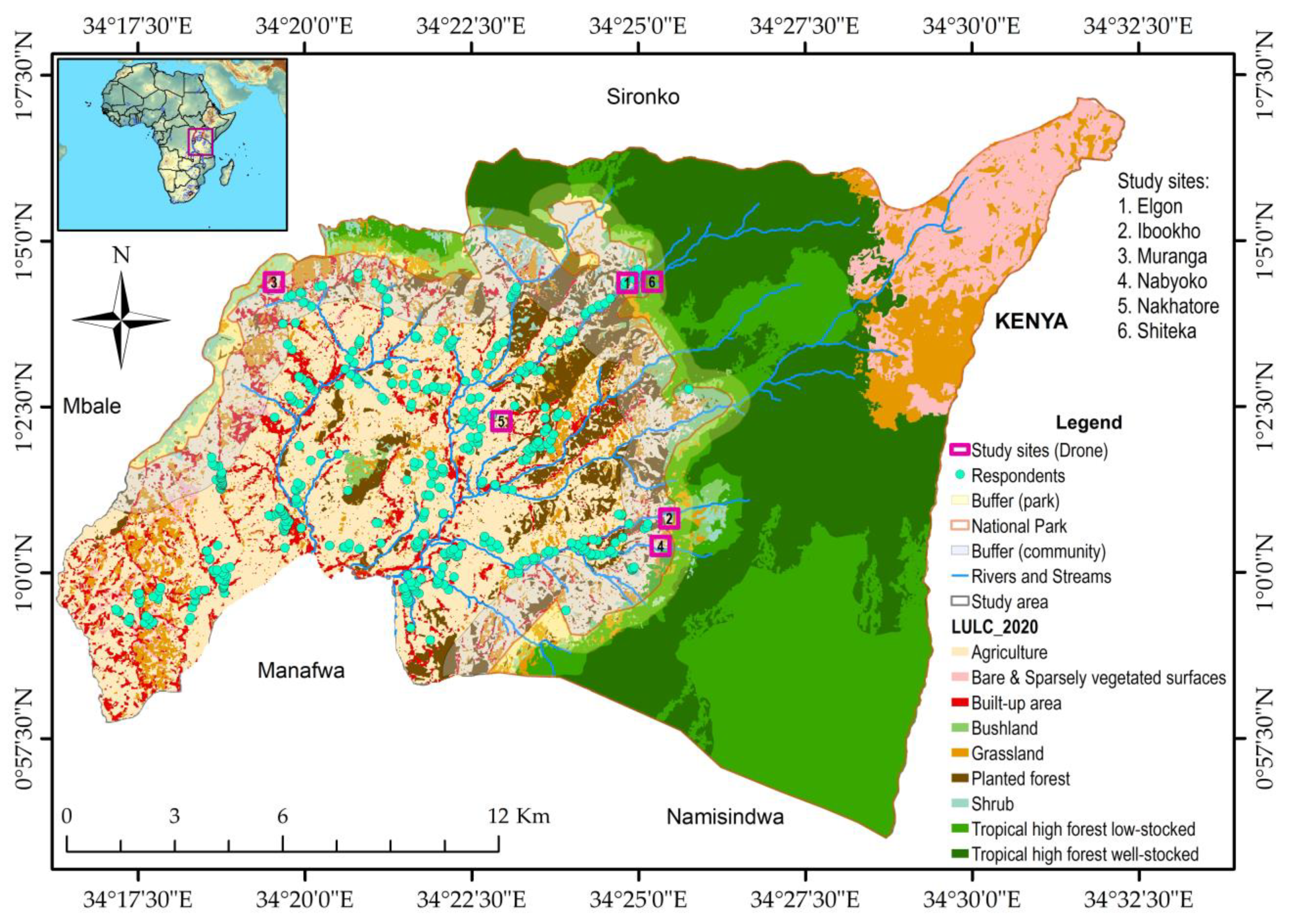


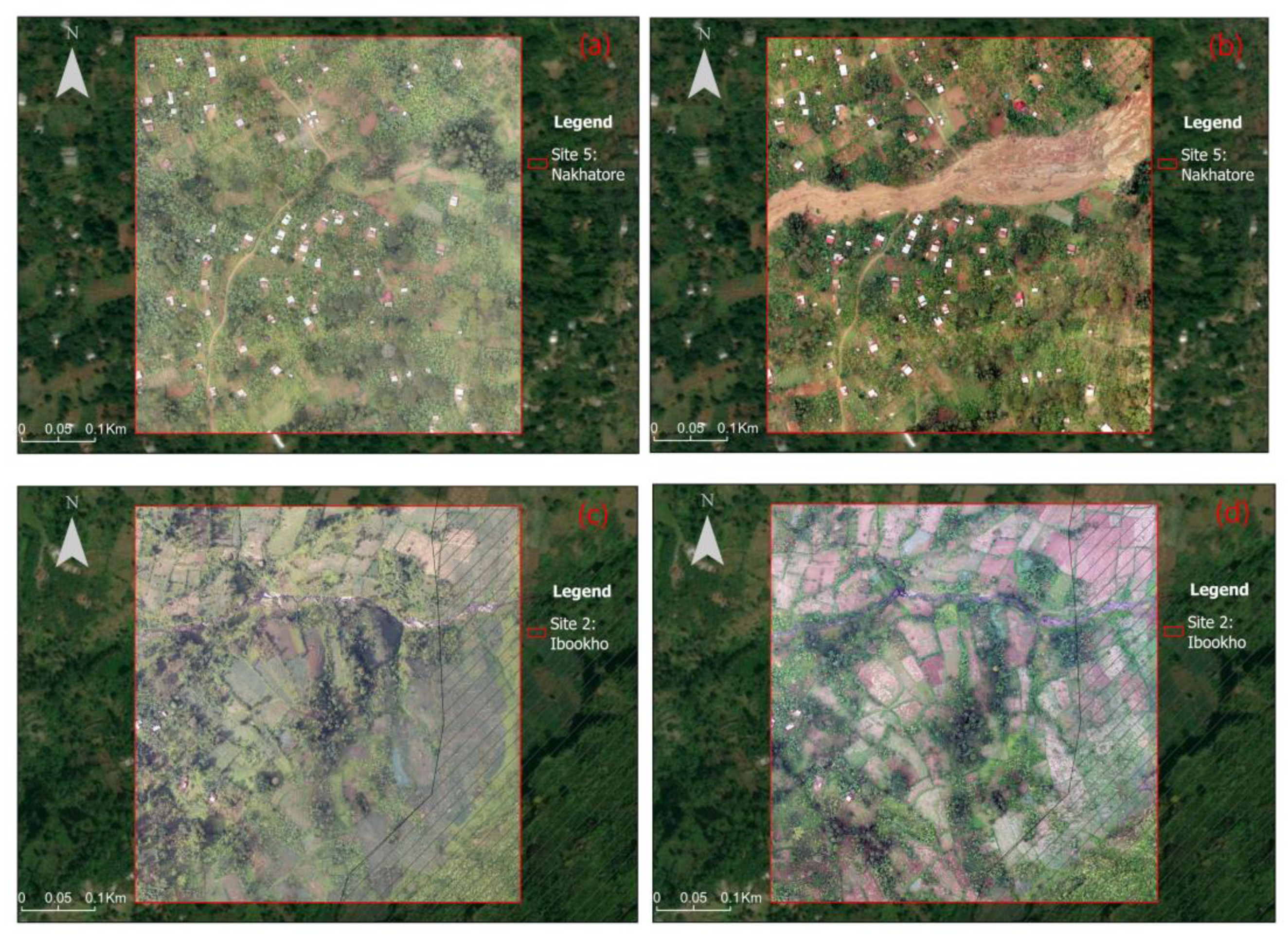
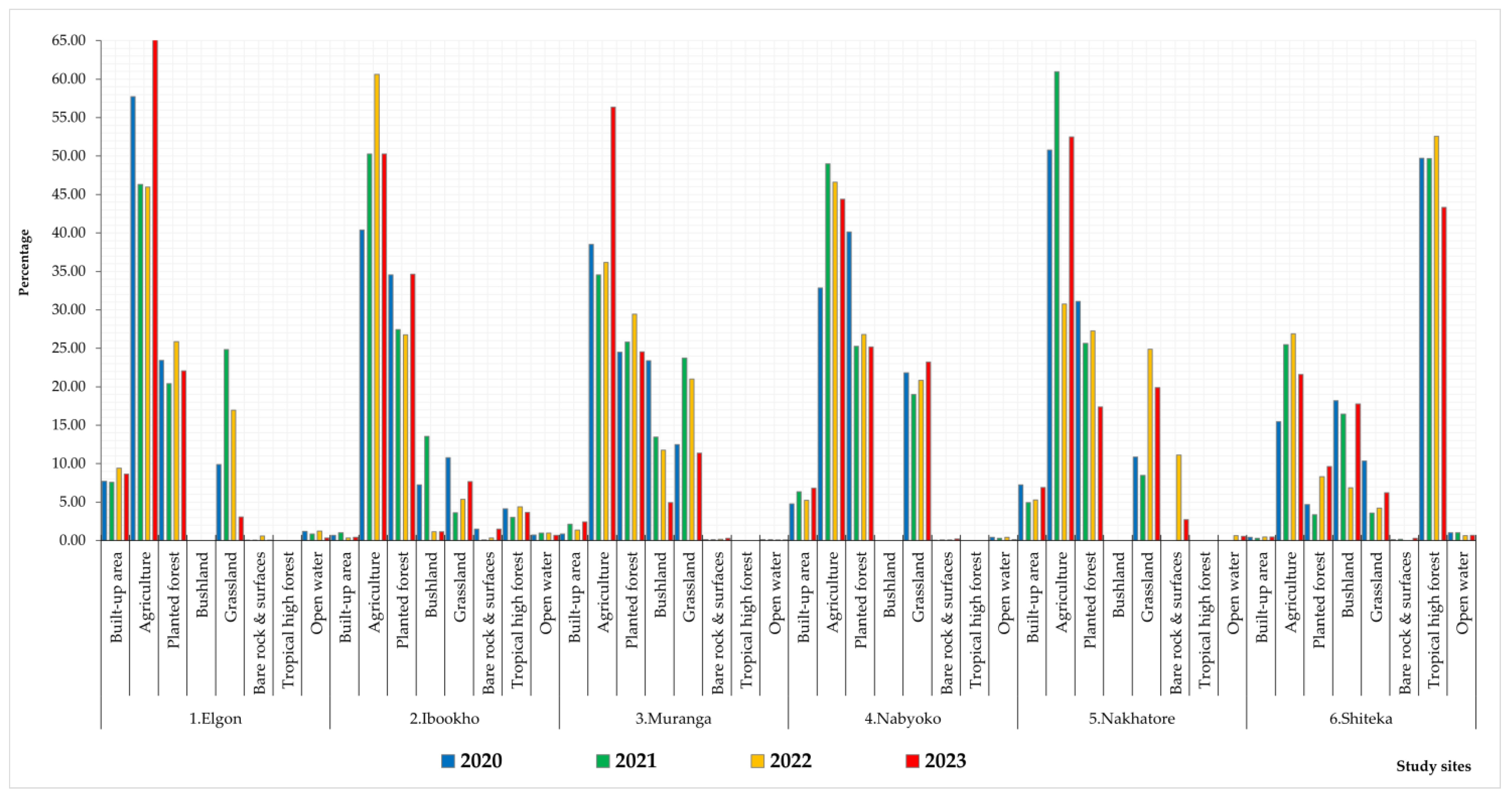
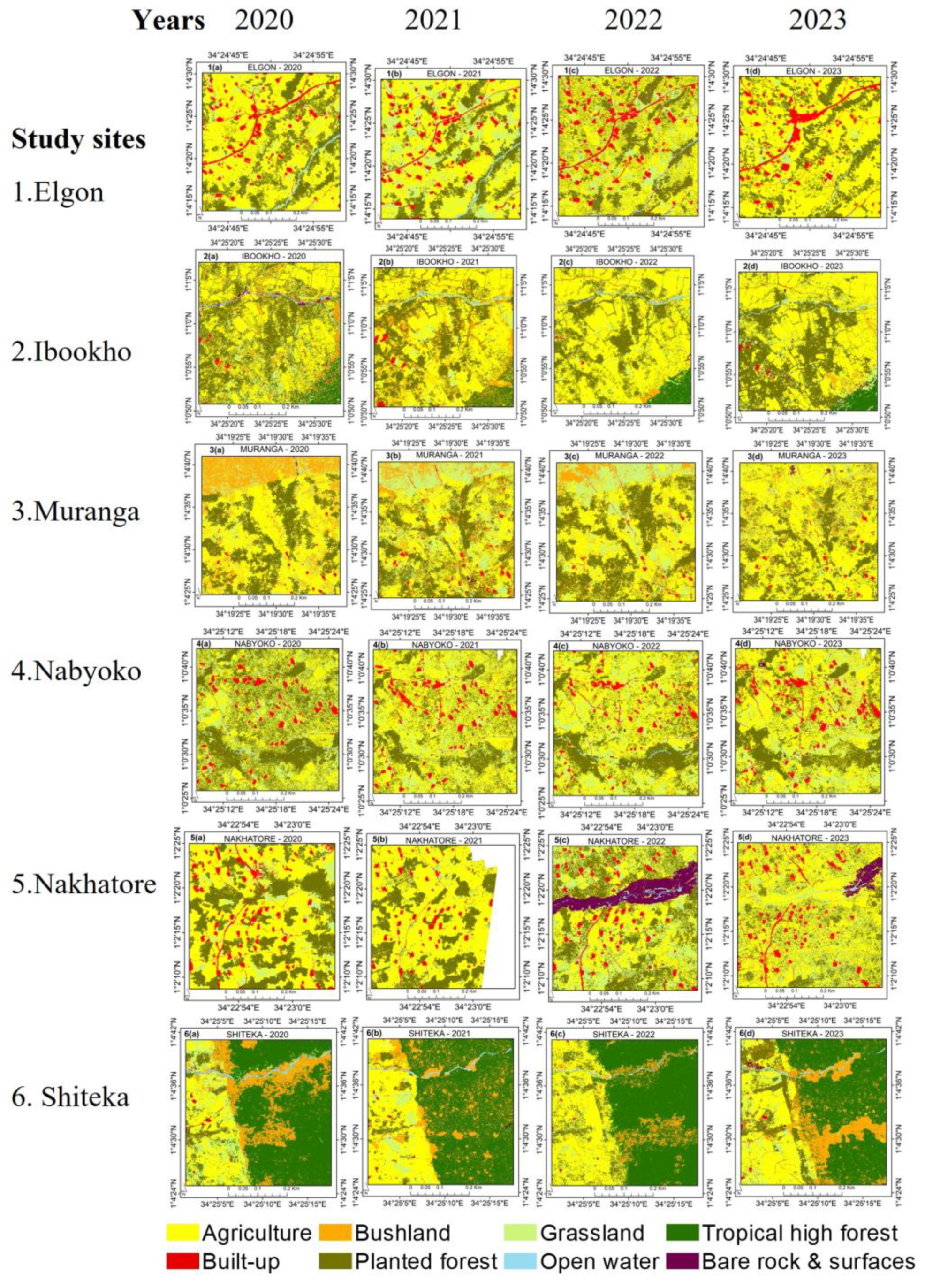
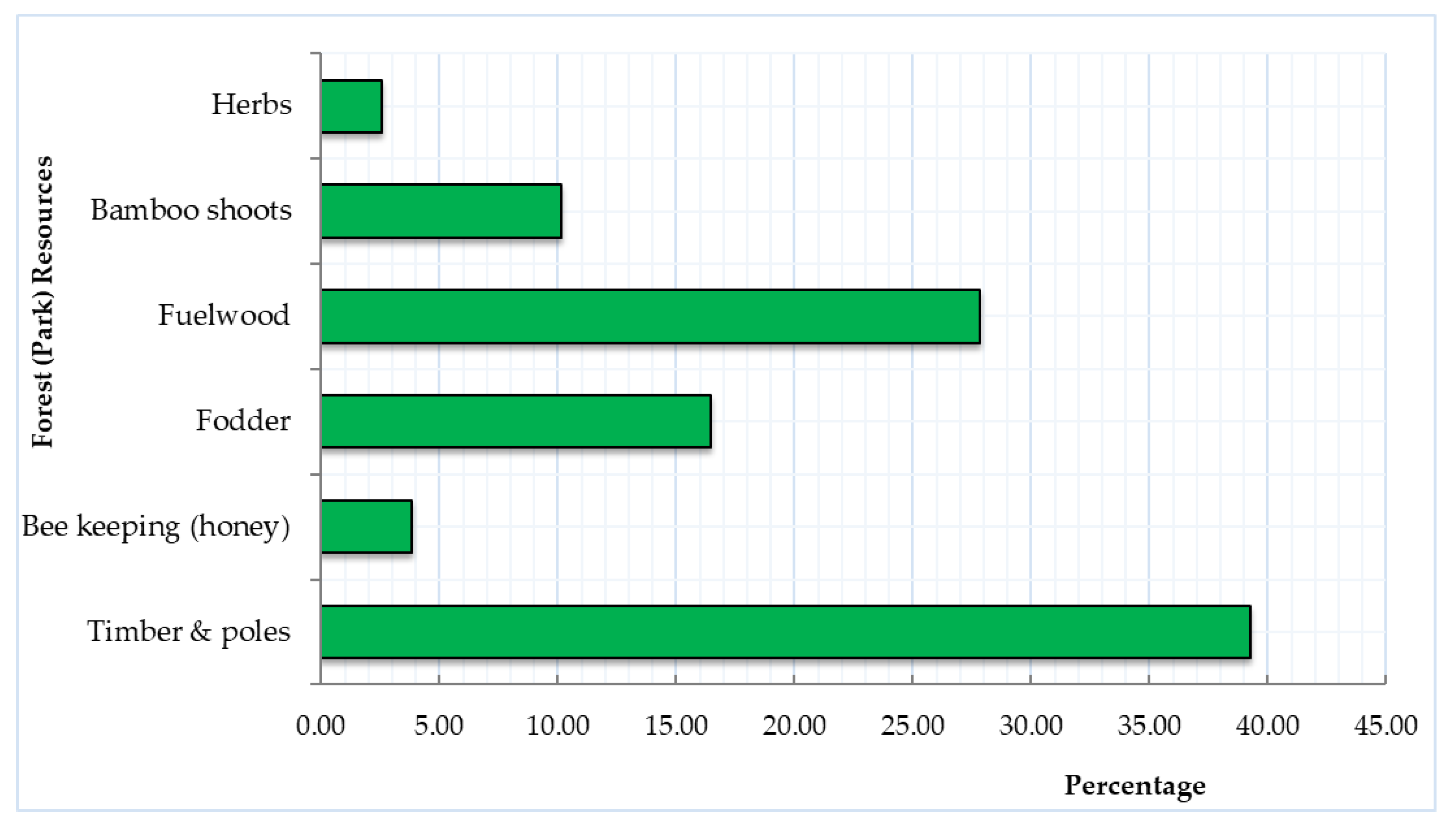
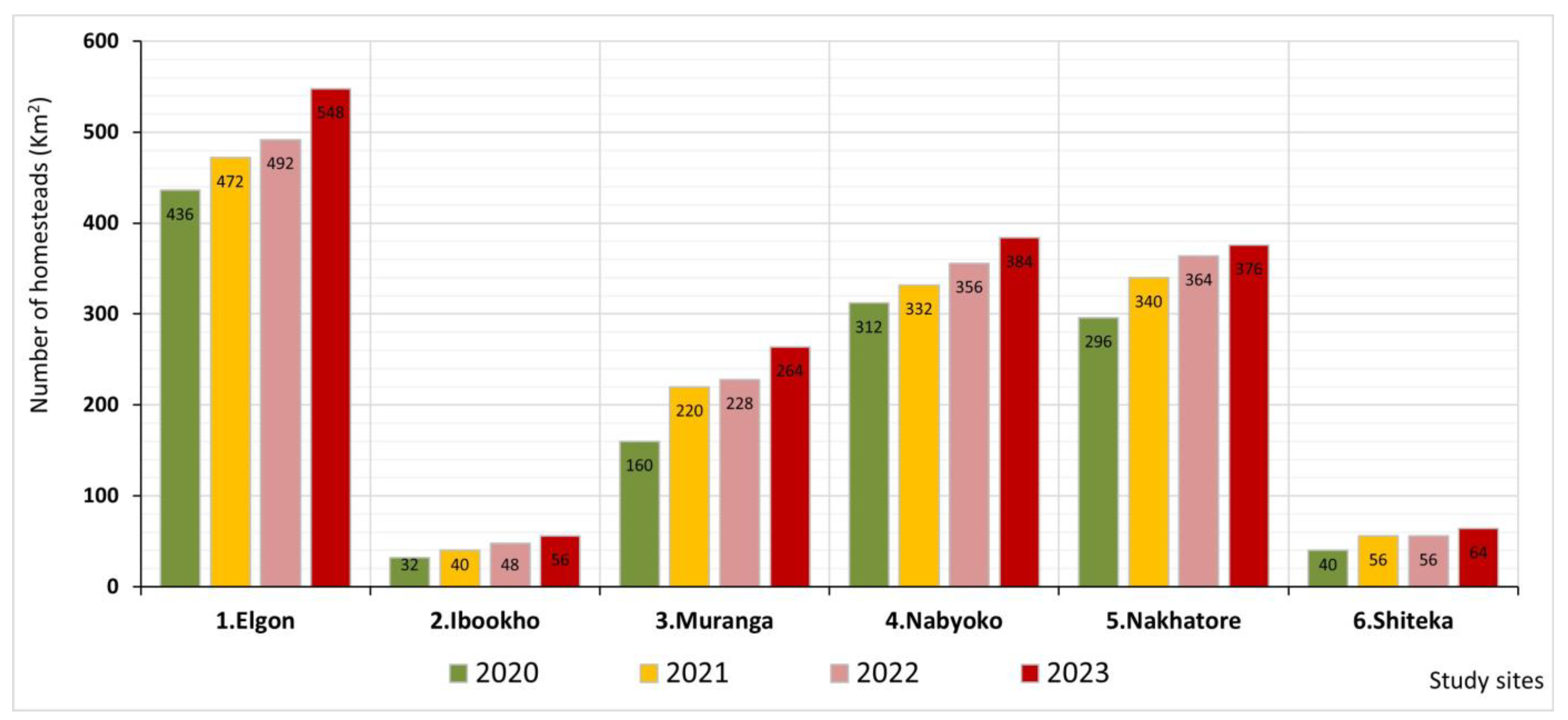

| LULC Class | Description |
|---|---|
| Built-Up area | Areas with buildings and artificially paved surfaces including rural and urban residential and service areas, transportation and communication routes. |
| Agriculture | Land area under subsistence farming of perennial and/or annual crops, especially banana–coffee (Musa spp-Coffea canephora) plantations throughout the year, with scattered fruit trees and intercropping of annual crops like beans, maize, and vegetables, with reduced cover after crop harvest. |
| Planted forest | Forests of planted broad-leaved woody trees and/or evergreen needle-shaped leaved trees with top-layer trees <65% cover. Undergrowth of small trees, shrubs, and grasslands exists. |
| Bushland | Natural and/or human-planted vegetation dominated by shrubs and thickets intermixed with bunches of grasses as an entity, but not exceeding an average height of 4 meters. |
| Grassland | Natural or human-planted extensively used grasslands, but not exceeding an average height of 0.5 m, with or without farm structures like shelters, enclosures, and watering places. |
| Bare rock and surfaces | Exposed rocks and the vegetation cover never exceeds 5% during any time of the year and stony (≥40%). Includes rock outcrops, accumulation of rock without vegetation, and active erosion surfaces. |
| Tropical high forest | Primary mixed natural forest (intact and/or degraded) with indigenous trees, top-layer trees’ ≥20% canopy cover. Second layer mixed with shrubs and bush, an annual cycle of leaf-on and leaf-off periods for degraded areas, whereas broadleaf trees remain green all year with green canopy foliage. |
| Open Water | All forms of water surfaces represented by line features (rivers, streams, and tributaries) and area features, especially man-made reservoirs of water for irrigation and flood control. |
| Household Attributes (Units) | Value | Std. Dev. | Min | Max |
|---|---|---|---|---|
| Gender (male, %) | 62.00 | |||
| Age group (31–64 years, %) | 73.00 | |||
| Migration Status (native, %) | 44.20 | |||
| Mean household size (no) | 7.01 | 3.05 | 1.00 | 18.00 |
| Land tenure system (Customary land, %) | 50.50 | |||
| Mean land size (acre) * | 2.08 | 1.90 | 0.25 | 20.00 |
| Education level (primary, %) | 60.72 | |||
| Main Occupation (subsistence farming, %) | 99.00 | |||
| Mean income (≤USD415/year, %) ** | 45.80 | 272.30 | 28.17 | 2140.85 |
| Main energy source for cooking (fuelwood, %) | 100.00 | |||
| Major cooking stove (three-stones open fire, %) | 66.90 |
| Land Degradation | Frequency | Percentage | Soil Erosion | Frequency | Percentage |
|---|---|---|---|---|---|
| Riverbank erosion | 89 | 7.21 | Gullies | 213 | 20.60 |
| Soil erosion | 416 | 33.71 | Rills | 357 | 34.53 |
| Landslides | 192 | 15.56 | Sheetwash | 201 | 19.44 |
| Offsite degradation | 23 | 1.86 | Rain splash | 258 | 24.95 |
| Surface crusting | 45 | 3.65 | Pediments | 5 | 0.48 |
| Vegetation cover decline | 156 | 12.64 | Total | 1034 | 100 |
| Flash floods and flooding | 91 | 7.37 | |||
| Loss of organic matter | 219 | 17.75 | |||
| Other forms | 3 | 0.24 | |||
| Total | 1234 | 100 |
| Encroached Park Area (Hectares) * | Annual Rate of Change (Percentage) | ||||||
|---|---|---|---|---|---|---|---|
| Study Sites | 2020 | 2021 | 2022 | 2023 | 2020–2021 | 2021–2022 | 2022–2023 |
| 2. Ibookho | 4.04 | 4.80 | 5.54 | 6.59 | 18.85 | 15.36 | 18.98 |
| 3. Muranga | 1.07 | 2.29 | 2.85 | 4.42 | 114.63 | 24.36 | 55.21 |
| 6. Shiteka | 2.63 | 3.13 | 4.21 | 4.15 | 18.80 | 34.62 | −1.35 |
| Adopted Soil and Water Conservation (SWC) Measures * | Frequency | Percentage |
|---|---|---|
| Vegetation/soil cover | 370 | 20.65 |
| Organic matter/soil fertility | 250 | 13.95 |
| Soil surface treatment | 152 | 8.48 |
| Subsurface treatment | 25 | 1.40 |
| Tree and shrub cover | 216 | 12.05 |
| Grasses and perennial herbaceous plants | 225 | 12.56 |
| Clearing part of the vegetation | 86 | 4.80 |
| Bench terraces | 148 | 8.26 |
| Bunds | 36 | 2.01 |
| Graded ditches and waterways | 31 | 1.73 |
| Soil surface treatment | 113 | 6.31 |
| Major change in timing of activities | 37 | 2.06 |
| Control/change in species composition | 63 | 3.52 |
| Other measures | 2 | 2.23 |
| Total | 1754 | 100 |
| Study Sites | Area (Hectares) | Annual Rate of Change (Percentage) | |||||
|---|---|---|---|---|---|---|---|
| Forest * | 2020 | 2021 | 2022 | 2023 | 2020–2021 | 2021–2022 | 2022–2023 |
| 2. Ibookho | 2.36 | 1.73 | 1.23 | 0.97 | −26.87 | −29.13 | −20.49 |
| 3. Muranga | 3.54 | 2.47 | 0.49 | 0.26 | −30.12 | −80.15 | −46.66 |
| 6. Shiteka | 17.18 | 16.36 | 15.42 | 15.54 | −4.76 | −5.72 | 0.73 |
| Tree plantations ** | |||||||
| 1 Elgon | 0.63 | 0.67 | 1.18 | 1.42 | −7.46 | 6.06 | 39.74 |
| 2. Ibookho | 1.49 | 1.38 | 1.46 | 2.04 | 7.01 | 74.95 | 20.81 |
| 3. Muranga | 0.98 | 0.99 | 1.17 | 1.81 | 1.23 | 18.21 | 54.64 |
| 4. Nabyoko | 2.33 | 2.55 | 2.48 | 3.39 | 9.46 | −2.64 | 36.51 |
| 5. Nakhatore | 1.44 | 1.72 | 0.63 | 0.62 | 19.75 | −63.56 | −1.74 |
| 6. Shiteka | 0.32 | 0.46 | 0.89 | 1.38 | 42.04 | 92.11 | 56.16 |
Disclaimer/Publisher’s Note: The statements, opinions and data contained in all publications are solely those of the individual author(s) and contributor(s) and not of MDPI and/or the editor(s). MDPI and/or the editor(s) disclaim responsibility for any injury to people or property resulting from any ideas, methods, instructions or products referred to in the content. |
© 2023 by the authors. Licensee MDPI, Basel, Switzerland. This article is an open access article distributed under the terms and conditions of the Creative Commons Attribution (CC BY) license (https://creativecommons.org/licenses/by/4.0/).
Share and Cite
Opedes, H.; Nedala, S.; Mücher, C.A.; Baartman, J.E.M.; Mugagga, F. How Can Drones Uncover Land Degradation Hotspots and Restoration Hopespots? An Integrated Approach in the Mount Elgon Region with Community Perceptions. Land 2024, 13, 1. https://doi.org/10.3390/land13010001
Opedes H, Nedala S, Mücher CA, Baartman JEM, Mugagga F. How Can Drones Uncover Land Degradation Hotspots and Restoration Hopespots? An Integrated Approach in the Mount Elgon Region with Community Perceptions. Land. 2024; 13(1):1. https://doi.org/10.3390/land13010001
Chicago/Turabian StyleOpedes, Hosea, Shafiq Nedala, Caspar A. Mücher, Jantiene E. M. Baartman, and Frank Mugagga. 2024. "How Can Drones Uncover Land Degradation Hotspots and Restoration Hopespots? An Integrated Approach in the Mount Elgon Region with Community Perceptions" Land 13, no. 1: 1. https://doi.org/10.3390/land13010001
APA StyleOpedes, H., Nedala, S., Mücher, C. A., Baartman, J. E. M., & Mugagga, F. (2024). How Can Drones Uncover Land Degradation Hotspots and Restoration Hopespots? An Integrated Approach in the Mount Elgon Region with Community Perceptions. Land, 13(1), 1. https://doi.org/10.3390/land13010001









